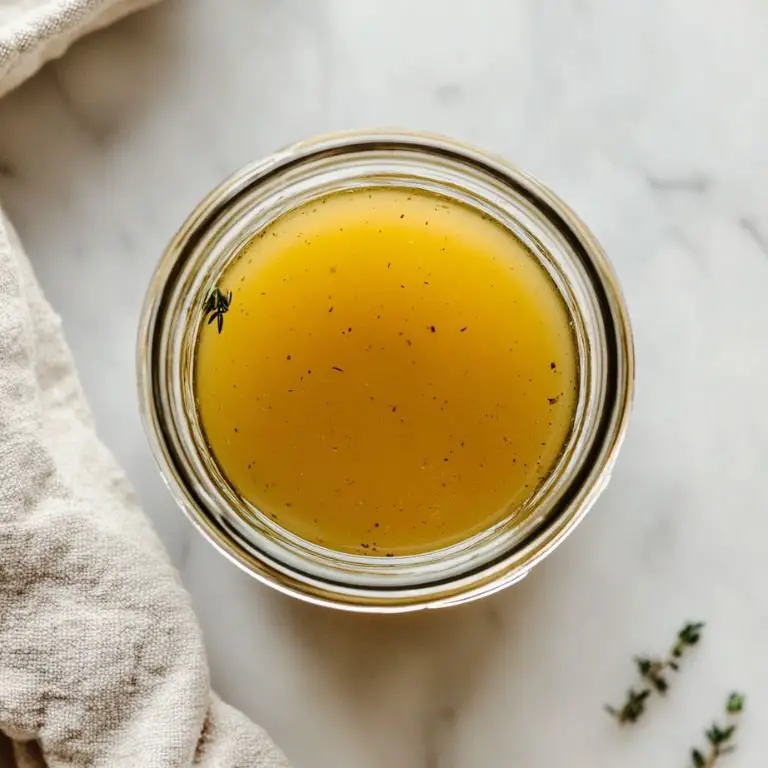There’s something timeless and soul-soothing about a rich, aromatic homemade chicken stock bubbling away in your kitchen. This isn’t the watery broth from a carton—it’s a deep, savory elixir made from scratch that transforms everyday dishes into something extraordinary. Whether you use bones from a Sunday roast or the remains of a rotisserie chicken, this recipe is a masterclass in getting the most flavor out of humble ingredients. You’ll want to make a big batch and freeze it, because once you taste it, you'll never go back to store-bought again.
Homemade Chicken Stock with Deep, Savory Flavor
Prep Time 15 minutes mins
Cook Time 8 hours hrs
Total Time 8 hours hrs 15 minutes mins
Course Recipe Component
Cuisine American, French
Servings 10 cups of stock
Large stockpot (at least 8-quart) A wide, heavy-bottomed pot helps distribute heat evenly and allows for longer simmering without burning.
Fine mesh strainer To separate the liquid from solids at the end.
Ladle For skimming fat and serving.
Tongs or slotted spoon Useful for removing bones and large vegetables.
Storage containers or mason jars For refrigerating or freezing the stock.
- Chicken bones: 3–4 pounds of bones. You can use raw bones roasted chicken bones, or a mix. Bones from a rotisserie chicken work great and add extra flavor.
- Cold water: About 12 cups or enough to cover the bones by 1–2 inches.
- Onion: 1 large quartered (leave the skin on for a deeper color).
- Carrots: 2 medium chopped into large pieces.
- Celery: 2 stalks chopped into large pieces.
- Garlic: 4 cloves smashed.
- Bay leaves: 2 whole.
- Black peppercorns: 1 tablespoon.
- Apple cider vinegar or white vinegar: 1 tablespoon helps draw nutrients from the bones.
- Fresh parsley or thyme: A handful optional.
- Salt: Add to taste at the end or leave unsalted if you want to control salt in later recipes.
Step 1: Prepare the Bones and Vegetables
If you're using raw bones, you can roast them at 400°F for 30 minutes to deepen the flavor (this step is optional but highly recommended). Toss them on a baking sheet with onions, carrots, and celery for even more caramelization.
Step 2: Load Up the Pot
Place bones in the stockpot and cover with cold water. Add vinegar, vegetables, garlic, bay leaves, and peppercorns. Bring to a gentle simmer over medium-high heat.
Step 3: Skim the Scum
As the stock begins to simmer, you’ll notice a grayish foam rising to the top. Skim it off with a ladle and discard. This helps create a cleaner, clearer stock.
Step 4: Simmer Low and Slow
Turn the heat to low and let the stock barely bubble for about 8 hours. Avoid boiling—it makes the stock cloudy and bitter. Keep the lid slightly ajar to allow steam to escape and the stock to reduce gently.
Step 5: Strain and Store
Once the stock is rich and golden, remove from heat. Use a fine mesh strainer to strain into a large bowl or pot. Let cool, then store in the refrigerator (up to 5 days) or freeze in batches (up to 3 months).
Pairings: What to Use This Stock In
Homemade chicken stock is the flavor base of countless dishes. Here are a few ideas:
- Soups & Stews: Elevate your classic chicken noodle soup or a hearty lentil stew.
- Risottos: Replace water with stock for extra depth.
- Gravies & Sauces: A great stock turns pan drippings into luscious gravy.
- Rice and grains: Cook your rice, quinoa, or couscous in stock for added richness.
- Braises: Use it as a braising liquid for chicken, pork, or even lamb.
You can also sub this chicken stock into recipes that call for other types of stock. For example, it can be an easy stand-in for vegetable stock recipe bases when you want a heartier flavor. If you’re diving into seafood dishes, check out seafood stock recipes that use a similar technique with shrimp shells or fish bones. Curious about other types of stock? We’ve tried and loved a beef stock recipe made with marrow bones and a robust turkey stock recipe that’s perfect after Thanksgiving.
FAQs
1. What type of chicken bones should I use?
Use a mix of bones and connective tissue: backs, necks, wings, and even feet. These parts contain a lot of collagen, which gives stock its body. Roasted bones add more depth, while raw bones create a lighter flavor. Chicken stock from rotisserie chicken is a smart shortcut that already packs roasted flavor.
2. Can I use meat on the bones?
Yes, but too much meat can result in a soupier, less “stock-like” result. Aim for mostly bones with bits of meat attached. A little meat adds flavor, but the goal is extracting nutrients and collagen from the bones.
3. How is this different from broth?
Broth is typically made with more meat and less cooking time, while stock is all about the bones and long simmering. Stock is thicker, more gelatinous when chilled, and has deeper flavor.
4. Can I make this with other proteins?
Definitely! You can follow a similar process to make a fish stock recipe using white fish bones, or a vegetable stock recipe with mushrooms, onions, and carrots. The method also works beautifully for a beef stock recipe using marrow and knuckle bones or a turkey stock recipe after a holiday meal.
5. How do I make this in an Instant Pot or Crockpot?
- Chicken Stock Instant Pot: Use the “Soup/Broth” setting and cook for 1 hour on high pressure with a natural release.
- Crockpot Chicken Stock: Set to low and simmer for 10–12 hours, or overnight. No need to babysit it!
